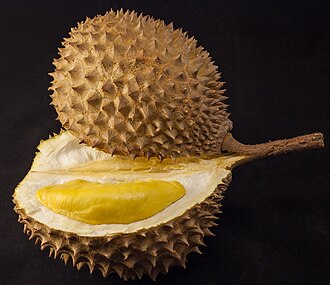Durian
Gematria Values
Durian (Durio spp.) is a genus of large, tropical trees native to Southeast Asia that produces some of the largest fruits in the world. Known as the "king of fruits" in many regions, durian is renowned for its distinctive odor, which is strong and often described as resembling rotten onions, turpentine, or gym socks. This pungent aroma has led to the fruit being banned in some public places, such as hotels and airports, across Southeast Asia. In Thailand, durian is called thurian (ทุเรียน), while in Malaysia and Indonesia, it is known as duri and duren, respectively. The fruit is highly prized in these countries and is a common ingredient in various desserts and sweet dishes. Despite its polarizing smell, durian is cherished for its creamy, custard-like texture and sweet taste, which has earned it a dedicated following among fruit enthusiasts worldwide. The tree itself can grow up to 25–50 meters (82–164 feet) tall, with large, evergreen leaves and a thick, fire-resistant trunk. Durian trees typically begin to bear fruit after 5–6 years, with peak production occurring between 15–20 years. The fruit itself is large, spiky, and can weigh up to 3–4 kilograms (6.6–8.8 pounds), with a husk covered in sharp, prickly thorns. Inside, the fruit contains a soft, edible flesh that surrounds a single large seed. Durian is rich in nutrients, including vitamins C and B6, potassium, and dietary fiber, making it a valuable addition to a balanced diet. However, it is also high in calories and fat, so it should be consumed in moderation. The fruit's unique characteristics and cultural significance have made it a subject of fascination and debate, with some people loving its intense flavor and aroma, while others find it overwhelming and unpleasant.
Wikipedia Information
